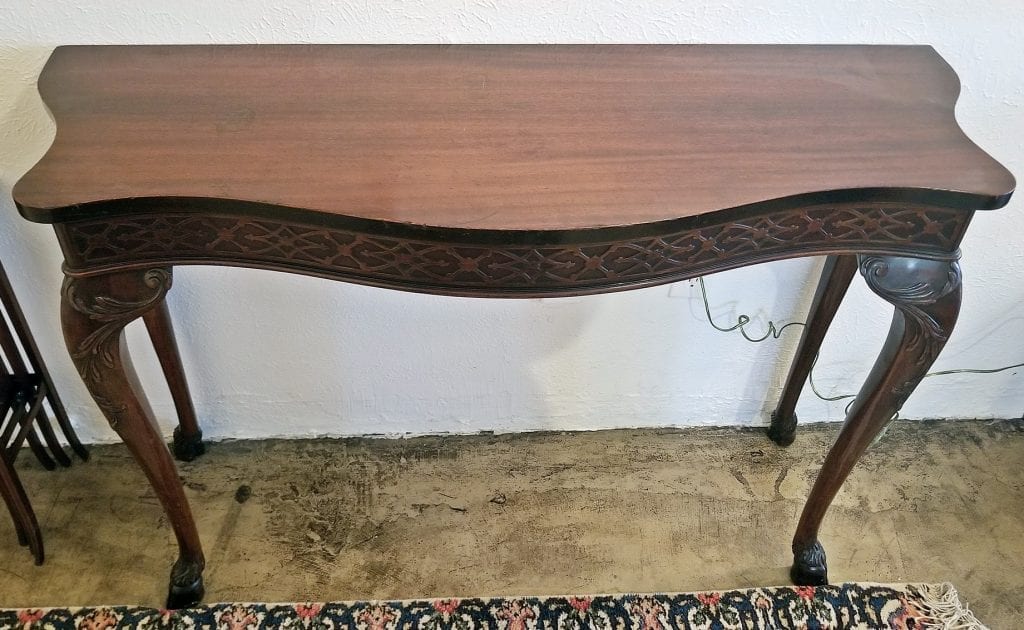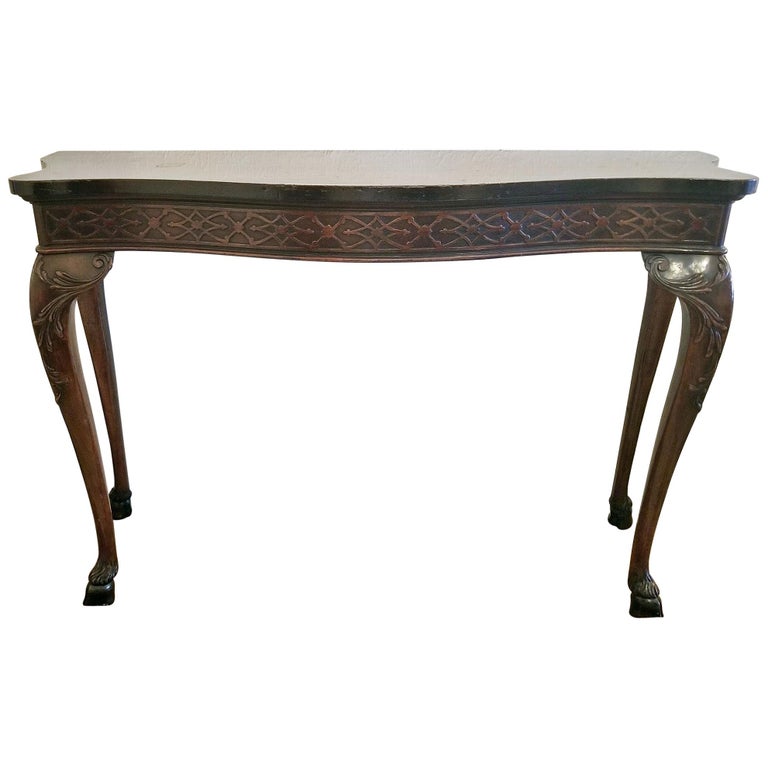Chippendale Style Console Table with Hoof Feet
PRESENTING a LOVELY early 20th Century Chippendale Style Console Table with Hoof Feet, of neat proportions.
From circa 1900-20, this table is in the classic Chippendale style.
Curved serpentine top.
It sits on four carved curved legs, with acanthus leaf carving on the knees and 4 ‘cloven hoof feet’ at the base.
Gorgeous Chinese style relief molding carved into the face and sides of the table, just below the plain mahogany top.
Made of mahogany.
Possibly British, but most likely, American.
Thomas Chippendale (1718 – 1779) was born in Otley in the West Riding of Yorkshire, England in June 1718. He became a cabinet-makerin London, designing furniture in the mid-Georgian, English Rococo, and Neoclassical styles. In 1754 he published a book of his designs, titled The Gentleman and Cabinet Maker’s Director, upon which success he became renowned. The designs are regarded as reflecting the current British fashion for furniture of that period and are today reproduced globally. He was buried 16 November 1779, according to the records of St Martin-in-the-Fields, in the cemetery since built upon by the National Gallery. Chippendale furniture is highly valued; a padouk cabinet that came up for auction in 2008 sold for £2,729,250.
Chippendale was born the only child of John Chippendale (1690–1768), joiner, and his first wife Mary (née Drake) (1693–1729). He received an elementary education at Prince Henry’s Grammar School. The Chippendale family had long been in the wood working trades and so he probably received his basic training from his father, though it is believed that he was also trained by Richard Wood in York, before he moved to London. Wood later ordered eight copies of the Director. On 19 May 1748 he married Catherine Redshaw at St George’s Chapel, Mayfair and they had five boys and four girls.
In 1749 Chippendale rented a modest house in Conduit Court, near Covent Garden. In 1752 he moved to Somerset Court, off the Strand. In 1754 Chippendale moved to 60–62 St Martin’s Lane in London, where for the next 60 years the family business operated until 1813 when his son, Thomas Chippendale (Junior), was evicted for bankruptcy. In 1754 he also went into partnership with James Rannie, a wealthy Scottish merchant, who put money into the business at the same time as Chippendale brought out the first edition of the Director. Rannie and his bookkeeper, Thomas Haig, probably looked after the finances of the business. His wife, Catherine, died in 1772. After James Rannie died in 1766, Thomas Haig seems to have borrowed £2,000 from Rannie’s widow, which he used to become Chippendale’s partner. One of Rannie’s executors, Henry Ferguson, became a third partner and so the business became Chippendale, Haig and Co. Thomas Chippendale (Junior) took over the business in 1776 allowing his father to retire. He moved to what was then called Lob’s Fields (now known as Derry Street) in Kensington. Chippendale married Elizabeth Davis at Fulham Parish Church on 5 August 1777. He fathered three more children. In 1779 Chippendale moved to Hoxton where he died of tuberculosis and was buried at St Martin-in-the-Fields on 16 November 1779.
There is a statue and memorial plaque dedicated to Chippendale outside The Old Grammar School Gallery in Manor Square, in his home town of Otley, near Leeds, Yorkshire. There is a full-size sculpted figure of Thomas Chippendale on the façade of the Victoria and Albert Museum, London.
After working as a journeyman cabinet maker in London, in 1754, he became the first cabinet-maker to publish a book of his designs, titled The Gentleman and Cabinet Maker’s Director. Three editions were published, the first in 1754, followed by a virtual reprint in 1755, and finally a revised and enlarged edition in 1762, by which time Chippendale’s illustrated designs began to show signs of Neoclassicism. Chippendale had considerable competition during his active years, most notably Ince and Mayhew.
Link: https://en.wikipedia.org/wiki/Thomas_Chippendale
Chippendale Style Console Table with Hoof Feet
Provenance: From a Private Dallas Collection.
Condition: Very good condition.
Dimensions: 32.25 inches high, 48 inches wide, 17 inches deep.
PRICE: $1,800 – SALE PRICE NOW: $1,250



















